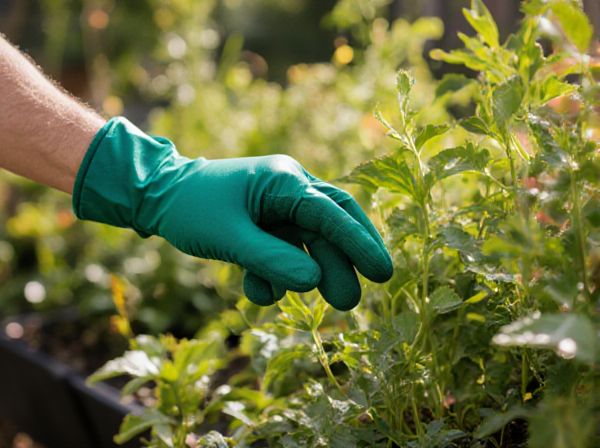
Integrated Pest Management (IPM) vs conventional pest control Illustration
Integrated Pest Management (IPM) emphasizes sustainable pest control by combining biological, cultural, and mechanical methods with minimal pesticide use, reducing environmental impact and promoting long-term pest suppression. Conventional pest control relies heavily on chemical pesticides for immediate pest elimination, often leading to resistance development and negative health effects. IPM offers a more ecologically balanced approach, enhancing crop health and safety while maintaining pest populations below damaging levels.
Table of Comparison
| Aspect | Integrated Pest Management (IPM) | Conventional Pest Control |
|---|---|---|
| Approach | Ecological and preventive strategies | Chemical-based, reactive methods |
| Pesticide Use | Minimal and targeted | Heavy and broad-spectrum |
| Environmental Impact | Low, promotes sustainability | High, risks pollution and resistance |
| Cost Efficiency | Long-term savings | Short-term cost, potential high overall |
| Effectiveness | Integrated tactics for lasting control | Immediate but temporary control |
| Health Risks | Reduced chemical exposure | Higher chemical exposure risk |
| Monitoring | Regular pest and damage assessment | Limited monitoring, treated on schedule |
Introduction to Integrated Pest Management (IPM) and Conventional Pest Control
Integrated Pest Management (IPM) employs a multi-faceted approach combining biological, cultural, mechanical, and chemical methods to manage pest populations sustainably while minimizing environmental impact. Conventional pest control typically relies heavily on chemical pesticides applied at regular intervals, often leading to pesticide resistance and non-target species harm. IPM prioritizes pest prevention and monitoring, using chemicals only when necessary, resulting in more effective long-term pest suppression and reduced ecological risks.
Defining IPM: A Holistic Approach to Garden Pest Management
Integrated Pest Management (IPM) is a holistic approach to garden pest management that emphasizes preventive measures, monitoring, and the judicious use of chemical treatments only when necessary. Unlike conventional pest control, which often relies heavily on routine pesticide applications, IPM integrates biological, cultural, physical, and chemical tools to manage pest populations sustainably. This method reduces environmental impact, promotes beneficial insect populations, and enhances long-term garden health and resilience.
Conventional Pest Control: Methods and Practices
Conventional pest control relies heavily on chemical pesticides, such as insecticides, herbicides, and fungicides, to rapidly eliminate pest populations. Common methods include broadcast spraying, fogging, and baiting, which often offer immediate results but carry risks of environmental contamination and pest resistance. Routine application and lack of targeted strategies can lead to non-selective impacts on beneficial organisms and ecosystems.
Key Differences between IPM and Conventional Pest Control
Integrated Pest Management (IPM) employs a combination of biological, cultural, mechanical, and chemical methods to control pests with minimal environmental impact, emphasizing prevention and monitoring. Conventional pest control primarily relies on the widespread application of chemical pesticides for immediate pest eradication, often disregarding long-term ecological consequences. IPM prioritizes sustainability and pest resistance management, whereas conventional methods may lead to pesticide resistance and environmental degradation.
Environmental Impact: IPM vs Conventional Pest Control
Integrated Pest Management (IPM) significantly reduces environmental impact by utilizing targeted techniques such as biological controls, habitat manipulation, and selective pesticide use. Conventional pest control often relies heavily on broad-spectrum pesticides, leading to soil degradation, water contamination, and harm to non-target species including beneficial insects. IPM promotes sustainable agriculture by minimizing chemical residues and preserving ecosystem health.
Effectiveness in Reducing Garden Pests
Integrated Pest Management (IPM) effectively reduces garden pests by combining biological, cultural, and mechanical control methods, minimizing reliance on chemical pesticides. Studies show IPM can lower pest populations by up to 70% while preserving beneficial insects and promoting long-term pest suppression. Conventional pest control often relies on chemical pesticides, which may offer immediate pest reduction but risks pest resistance and environmental harm over time.
Safety Concerns: Human Health and Wildlife
Integrated Pest Management (IPM) prioritizes safety by using targeted, environmentally friendly methods that minimize chemical exposure, reducing risks to human health and wildlife. Conventional pest control often relies on broad-spectrum pesticides that can lead to contamination, posing significant health hazards and disrupting ecosystems. IPM's emphasis on monitoring and threshold-based interventions promotes sustainable pest control with fewer adverse effects on non-target species.
Cost Comparison: Long-term vs Short-term Solutions
Integrated Pest Management (IPM) offers a cost-efficient long-term solution by reducing pesticide use and minimizing pest resistance, ultimately lowering recurring expenses. Conventional pest control often incurs higher short-term costs due to frequent chemical applications and potential damage from pesticide overuse. Over time, IPM's sustainable strategies lead to significant savings by promoting ecosystem balance and reducing the need for costly treatments.
Adoption Barriers and Challenges for Gardeners
Gardeners face significant adoption barriers in Integrated Pest Management (IPM) due to the complexity of monitoring pest populations and the need for specialized knowledge in pest identification and ecosystem balance. Conventional pest control offers simpler, immediate solutions with chemical pesticides, but IPM requires patience and ongoing observation, making it less appealing for casual or novice gardeners. Cost concerns and limited access to local IPM resources further challenge widespread acceptance among the gardening community.
Choosing the Best Pest Management Strategy for Your Garden
Integrated Pest Management (IPM) combines biological, cultural, and chemical tactics to minimize pest damage while promoting environmental health, making it a sustainable choice for garden care. Conventional pest control relies heavily on chemical pesticides, which may provide quick results but risk harming beneficial insects and polluting soil and water. Selecting IPM as your pest management strategy helps maintain biodiversity, reduce chemical resistance, and protect long-term garden productivity.
Integrated Pest Management (IPM) vs conventional pest control Infographic

 gardendif.com
gardendif.com